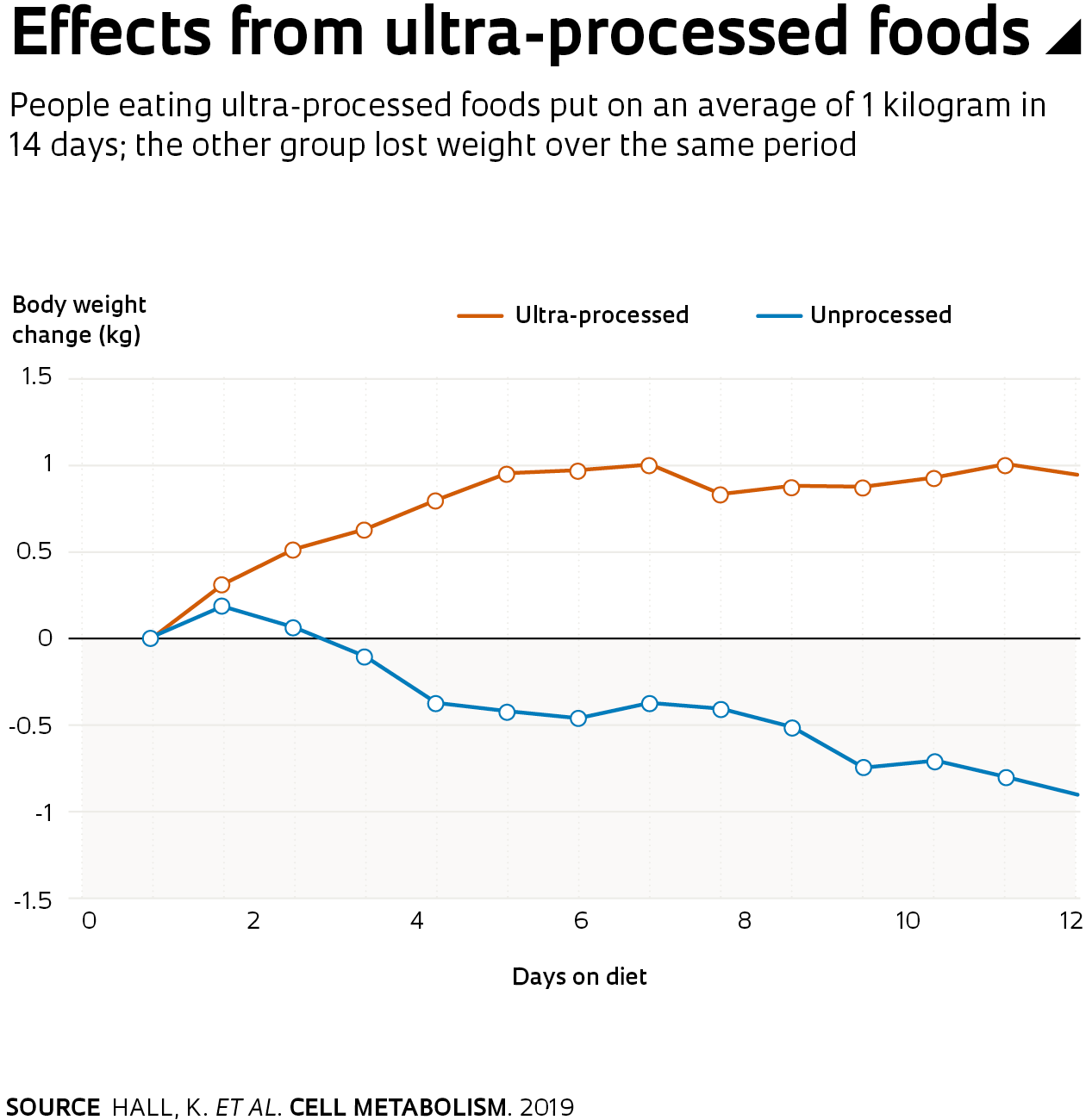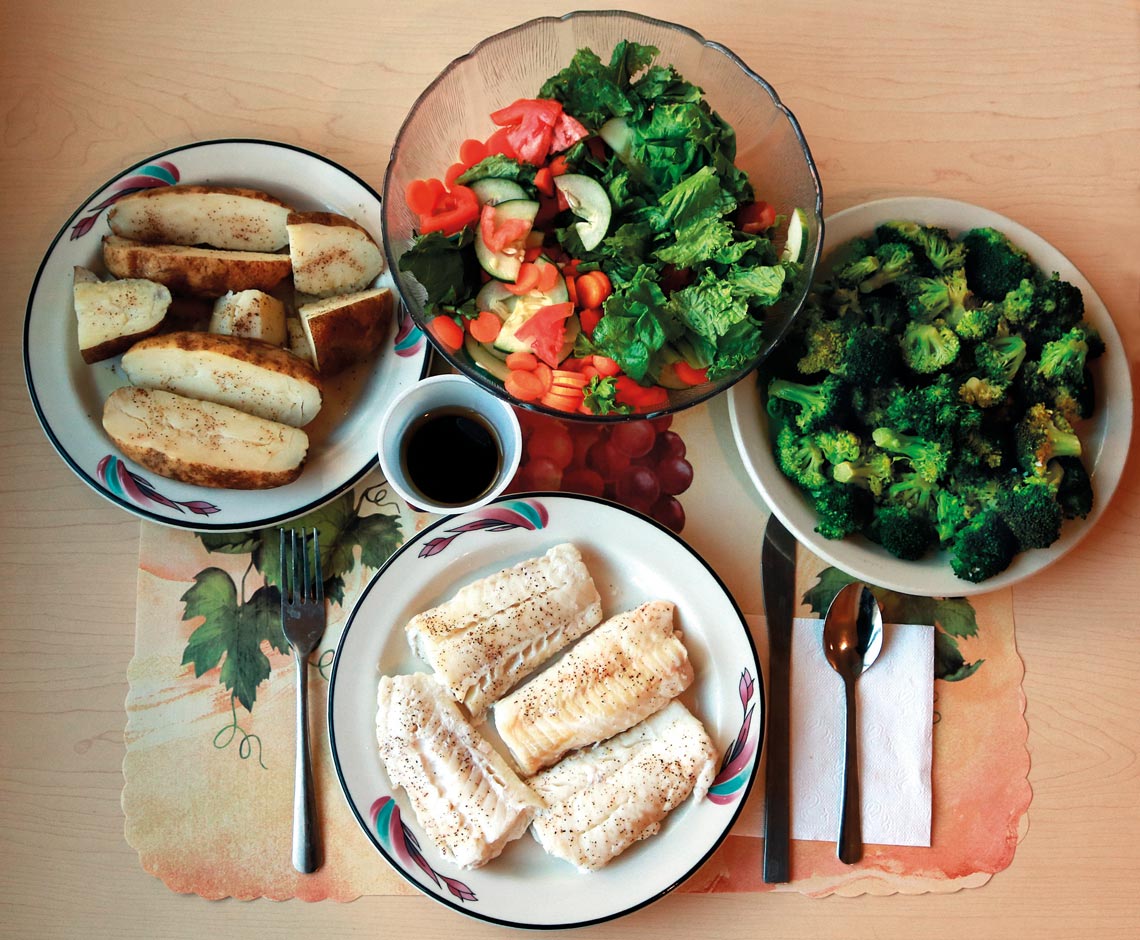Evidence continues to mount that a diet rich in ultra-processed foods can be harmful to health, leading many nutrition and public-health experts to recommend minimizing intake of foods that are high in sugars, fats, salt, and chemical compounds designed to increase durability or enhance aroma, color, and flavor.
In May this year alone, 10 new studies reported findings on the harmful effects of ultra-processed foods on human health. These trials—set in the US, France, Spain, and Brazil—mostly had very large numbers of subjects. Their results add to a growing body of evidence linking ultra-processed foods to increased blood pressure, elevated blood levels of sugar and fat, heart disease, and some types of cancer, as well as an increased overall risk for premature death.
The most significant of these studies, however, evaluated the impact of ultra-processed foods on only 20 volunteers. While the number of subjects was small, this trial used an experiment design that is considered the gold standard for identifying cause-and-effect relationships, known as a randomized controlled crossover trial. In this model, subjects are randomly separated into two groups that undergo different interventions (such as medical treatments or diets)—for instance A and B. Midway into the experiment, the interventions are swapped, and at the end the results for treatment A are compared to those for B.
Using this strategy, Kevin Hall and his team at the National Institutes of Health (NIH) showed for the first time that a diet primarily of ultra-processed foods leads to significant weight gain in a short amount of time: about 1 kilogram (kg) in the space two weeks. Published on May 16 in the journal Cell Metabolism, the study may also be the most rigorous test to date of a food classification proposed just over 15 years ago, and then formalized in 2009, by Brazilian epidemiologist Carlos Augusto Monteiro of the University of São Paulo School of Public Health (FSP-USP). The classification, dubbed NOVA, groups foods into four categories by level of processing: unprocessed or minimally processed; processed; ultra-processed; and processed culinary ingredients. NOVA was used as a basis for the Brazilian Ministry of Health’s 2014 Dietary Guidelines for Brazilians.

Paule Joseph and Shavonne Pocock / National Institutes of Health
Day 1, breakfast: Greek yogurt, fruits, nuts, granola, salt, lemon, and olive oil for the unprocessed menuPaule Joseph and Shavonne Pocock / National Institutes of HealthFood-processing engineers and researchers are not all in agreement with one of the four groups in the classification—ultra-processed—with many finding it inadequate and misleading. “Ultra-processing, meaning processing food more than is needed, can happen in both an industrial and in a household setting,” says food engineer Carmen Tadini, a professor in the Polytechnic School at USP and a researcher at the USP Food Research Center (FoRC), one of the Research, Innovation, and Dissemination Centers (RIDC) funded by FAPESP. “If you overcook your vegetables at home, you eliminate nutrients and have inadvertently made an ultra-processed food without adding a single synthetic industrial ingredient,” she explains. Rather than “ultra-processed,” she believes these foods would more aptly be termed as “additive-containing.”
For the study done in the US, Hall and collaborators admitted 20 weight-stable, healthy adults—10 men and 10 women—aged 30 to 33 to an NIH Clinical Center for 28 days. Subjects were randomized so that half received a diet in which 81% of energy intake was derived from ultra-processed food over a period of two weeks. These foods were served for breakfast, lunch, dinner, and between meals. The ultra-processed diet included muffins, breakfast cereals, sweetened and flavored yogurts, bread, margarine, diet juices, and canned or ready-to-eat meats, vegetables, and fruits. Between meals, participants in this group were given sandwich cookies and packaged snacks. The other 10 volunteers received mostly unprocessed or minimally processed food during the same two-week period (with 88% of calories coming from these foods). They ate vegetables, grains, and freshly cooked meats during meals, and nuts and fresh or dried fruits as snacks.
Meals were designed so that both ultra-processed and minimally processed meals had matching calories and nutrient content. Both types of meals had the same energy content and more calories than needed for a healthy adult. Participants could eat as much as they desired from their serving, meaning they were free to overeat.
During the experiment, participants in both groups performed one hour of exercise per day. They were also regularly monitored for hormonal and metabolic changes, and energy intake. After the first two weeks, the volunteers were swapped to the alternate diets for an additional two weeks: those previously on the ultra-processed diet received unprocessed or minimally processed foods, and vice versa. This reduced the likelihood that measured effects would be due to subjects’ individual traits.

“There were many who suggested that ultra-processed foods had negative effects not because of the degree of processing, but because they had higher levels of nutrients, salt, sugar, and fat, and less fiber,” Hall explained to Pesquisa FAPESP. So we ran the trial to investigate whether an ultra-processed diet would lead to higher calorie intake than an unprocessed diet with the same amount of calories, salt, sugar, fat, and fiber.”
The results were surprising even for Hall. “I wasn’t expecting such a wide difference,” he said in other interviews. During their two weeks on the ultra-processed diet, participants consumed an average of 500 kilocalories per day (almost one extra meal) more than those eating fresh or minimally processed food. The first group gained an average of 1 kg while the second lost a similar amount of weight over the same period of time. The same effect was observed when subjects’ diets were reversed: those on the ultra-processed diet consistently ate too many calories and put on weight.
“A causal relationship between ultra-processed foods and weight gain had not previously been shown in such a tightly controlled experiment,” says physician Licio Velloso, a professor at the University of Campinas (UNICAMP) and head of the Obesity and Comorbidities Research Center, another RIDC funded by FAPESP. “This paper provides proof of concept and can inform future studies with a larger and more diverse pool of subjects.”
One of the limitations of the study is the relatively small number of participants. “The influence of individual traits that lend to weight gain or loss would be diluted in a study with more volunteers,” says Eduardo Purgatto, a pharmaceutical engineer specializing in nutrition at the USP School of Pharmaceutical Science (FCF-USP) and a researcher at FoRC. “The weight gain observed in the study, however, is consistent.”

Paule Joseph and Shavonne Pocock / National Institutes of Health
Day 4, ultra-processed diet: hot dog, baked potato chips, ketchup, mustard, cranberry juice, and blueberry yogurt for lunch; and packaged snacks between mealsPaule Joseph and Shavonne Pocock / National Institutes of HealthThe finding that ultra-processed foods cause weight gain is not invalidated by the small sample size and the short duration of the study. “These limitations only prevent us from concluding that the effect will continue over long periods of time and will be valid across the entire population,” says Hall.
Smaller studies are generally limited in their ability to determine the effect of an intervention, in this case a diet primarily of ultra-processed foods. In the NIH trial, however, this does not appear to be the case. “The observed effect was so much more pronounced than the authors expected that the number of participants was irrelevant to their conclusion,” says Monteiro, the FSP-USP researcher who created the NOVA classification.
While concurring that the study is robust, Jarlei Fiamoncini, a researcher at FCF-USP and FoRC, believes it would have been more informative if the authors had measured how much of the energy intake was actually absorbed and how much was eliminated in feces.
While the trial was not designed to identify the mechanisms behind weight gain, the NIH team has offered several hypotheses to explain it. One is the difference in protein availability. Proteins accounted for 14% of the energy intake in the ultra-processed diet and 15.6% in the unprocessed diet. The difference may seem negligible (just 10.3% between the two), but it can have a significant effect on how the body functions. A diet low in protein is known to be less satiating. “The difference may have caused subjects to eat more ultra-processed foods until they met their protein needs,” explains Velloso.

Paule Joseph and Shavonne Pocock / National Institutes of Health
Day 4, unprocessed diet: for lunch, steamed broccoli, baked cod fillet, baked russet potato with olive oil, salad (lettuce, carrots, cucumber, and tomatoes), and vinaigrette; between meals, fruits and nutsPaule Joseph and Shavonne Pocock / National Institutes of HealthHall and his team estimate, however, that this effect explains less than half of the weight gain. Another finding potentially explaining the higher calorie intake is that the subjects eating ultra-processed foods—which contain more energy for a given volume of food—ate faster: on average, they consumed about 10 grams and 20 kilocalories more per minute than people who ate less processed foods. Apparently, this made subjects eat more before satiety signals reached the brain, causing them to gain weight. “Subjects eating unprocessed foods had increased levels of PYY, an appetite-suppressing hormone, and lower levels of ghrelin, a hunger hormone,” says Fiamoncini.
Some researchers suspect that people tend to eat more ultra-processed foods because these foods are engineered to be tastier and more palatable. Hall’s group, however, found no evidence that this was the case.
Another recent paper by Brazilian researchers found the same causal relationship as reported by the NIH team. In Pelotas, southern Brazil, a group led by epidemiologist Iná da Silva dos Santos at the Federal University of Pelotas (UFPEL) evaluated the diets and body composition of around 3,500 children born in 2004 in two different periods: first at the age of 6 then at age 11. Nutritionist Caroline Costa observed that half of the children derived 42% of their daily calorie intake from ultra-processed foods in the first assessment, then 33% when they were 11 years old. Despite the reduction, Costa found that every 100 grams of ultra-processed food eaten per day led to a 0.14 kilogram-per-square-meter (kg/m2) increase in fat mass index—a measure more accurately representing the buildup of fat in the body and a better predictor of risk for obesity-related metabolic problems, such as diabetes and changes in cholesterol levels, than other indexes.
“Calories from ultra-processed foods accounted for 58% of fat gain, suggesting that besides nutrition, other factors may be at play in the accumulation of body fat,” says Costa, who reported these findings in a doctoral thesis she defended in February this year and has now submitted for publication in international journals. “Preventing children from eating ultra-processed foods is important because habits acquired in childhood tend to persist for life,” says Costa.
Participants eating unprocessed foods had higher levels of appetite-suppressing hormone and lower levels of hunger hormone
These two studies add to the findings from other trials showing that a diet highly weighted in ultra-processed foods increases risk for adverse health outcomes. These other studies are much larger—involving thousands to tens of thousands of subjects—but are less tightly controlled. One is a cohort study called NutriNet-Santé. Since 2009, researchers have evaluated the dietary intake and health of 105,000 French participants at regular intervals. In 2018, the group reported that a 10 percentage-point increase in the share of ultra-processed foods in people’s diets increased the risk of developing cancer by 12%. Findings published in May in the British Medical Journal suggest that a like increase in dietary intake of ultra-processed foods elevates the risk for heart disease and stroke—the two leading causes of death globally—by more than 10%.
Another paper presented in the same journal in May, reporting on a study involving 19,000 adults by the Public University of Navarre, in Spain, suggests that for every additional serving of ultra-processed food, the overall risk of death rises 18%. “The fact that similar associations have been found in multiple studies with different populations reinforces the significance of these findings,” says Monteiro.
Researchers interviewed for this article agree that the amount of ultra-processed food in consumers’ diets needs to be reduced, even though these foods can provide an important supply of energy to sustain life in certain situations, such as when there are food shortages. They also agree that ultra-processed foods are not the only factor behind the global obesity epidemic, a problem stemming from multiple causes. Purgatto, of FCF-USP, says the current debate is important in helping the food industry produce better-quality food products.
In the early 2000s, epidemiologist Carlos Augusto Monteiro and his team at FSP-USP realized the need for a new approach to classifying food. The group was trying to make sense of an apparent contradiction between Brazilians’ declining consumption of sugar, salt, and oil for cooking, and growing rates of obesity, two trends reported in national surveys by the Brazilian Institute of Geography and Statistics (IBGE). They found that while consumers were buying less of these cooking ingredients, the average content of sugar, salt, and fat in the basic food basket was rising. “The reason was that people were buying more ready-to-eat foods rich in sugar, salt, and fat,” says Monteiro. He and his collaborators designated these foods as “ultra-processed” foods, one of the four categories of their NOVA classification (described below). Based on the new classification, in 2014 the Brazilian Ministry of Health published Dietary Guidelines for Brazilians that recommended eating a variety of unprocessed or minimally processed foods, reducing intake of processed foods, and avoiding ultra-processed foods.
Unprocessed or minimally processed foods: foods derived from plants and animals, such as fruits, vegetables, grains, eggs, meats, and milk. Minimally processed foods have been slightly altered by cleaning, grinding, fractioning, drying, fermentation, refrigeration, freezing, and pasteurization.
Processed foods: foods made by adding salt, sugar, or other culinary ingredients to increase durability or enhance sensory qualities. Processed foods can be cooked, dried, canned, bottled, salted, cured, or smoked. Examples include canned fruits and vegetables, salted meats and salted or canned fish, live-fermented cheeses made of milk and salt, and breads made of flower, water, salt, and yeast.
Processed culinary ingredients: food ingredients derived from unprocessed foods or from nature by pressing, grinding, milling, spray drying, or refining. Examples include salt, sugar, olive oil, butter, and other ingredients used for seasoning, steam-cooking, frying, and otherwise cooking foods.
Ultra-processed: industrial formulations made entirely or mostly from substances extracted from foods (fat, sugar, protein), substances derived from food constituents (hydrogenated fat or modified starch), or synthetic substances (flavorings, artificial colors, and flavor enhancers). They involve multiple processing stages and methods, and multiple ingredients—typically more than five, some with no domestic equivalents. Examples include sweetened beverages, powdered beverage mixes, reconstituted meat products and other products derived from animal meat and fat, as well as ready-to-heat frozen foods and powdered foods (cake mixes, instant soups, and instant noodles). Other examples in this category include packaged snacks, breakfast cereals, and breads with added emulsifiers and other additives.
Project
Consumption of ultra-processed foods, dietary nutrient profile diet and obesity in seven countries (nº 15/14900-9); Grant Mechanism Thematic Project; Principal Investigator Carlos Augusto Monteiro (USP); Investment R$1,506,407.84.
Scientific article
HALL, K. D. et al. Ultra-processed diets cause excess calorie intake and weight gain: An inpatient randomized controlled trial of ad libitum food intake. Cell Metabolism. May 16, 2019.

